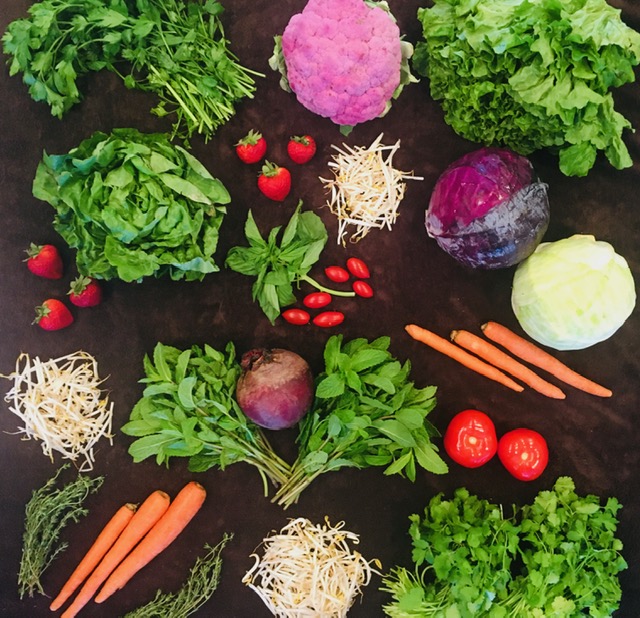
The Bounties of Spring
With a global food supply and transportation system, we take for granted that we can eat a wide variety of produce at any time of year. But many people have no idea what is in season when or what is grown locally where they live. If you have a big garden, you are more aware than most and this is the ultimate in eating seasonally and locally. But for those of you without a green thumb or who don’t have a garden big enough to meet all of your produce needs, here are some of the best reasons for eating local and in season as well as how to know what is local and in season near you.
Why shop local and in season
You’ll save money:
Perhaps the biggest tangible benefit of eating seasonally is that you’ll save money. When you buy what’s in season, you buy food when it’s at the peak of its supply, and produce prices are based in part on supply and demand, just as is with many other products. Another factor is the price of transportation. If you buy local, the food has travelled less to get to your store.
It tastes better and improves nutrition:
Less travel not only cuts costs, but also improves nutrition and taste, as many fruits and vegetables begin to degrade the moment they are picked. Just think about the difference between eating a freshly picked strawberry from your garden in the middle of summer vs. one that’s traveled a great distance to reach your table in January. Not only is it far less sweet and juicy, but it’s also less nutritious.
It’s better for the environment:
Just think about all the extra gas and carbon emissions and other countless factors involved with transporting food across the country or the ocean. Also better for the environment – choosing organic. All those pesticides, herbicides, fungicides, and other chemicals end up not only in your produce, but also in our soil, rain and ultimately your drinking water.
You’re supporting local farmers:
Eating local and in season also means you’re supporting local, and in most cases more sustainable farmers, rather than giant corporations or factory farms. Farmer’s markets are great places to shop local, as are CSAs, and many health food stores will highlight the produce that is local (look for signs).
What’s in season for spring?
So now let’s talk about what fruits and vegetables are in season from April to early June so you can immediately implement this in your shopping. What’s local will vary quite a bit as warmer locations will have more available locally all year long. Here’s a list of some commonly available spring produce, especially here in the northern part of the country. This list is by no means comprehensive, but my hope is that this will get you thinking about the bountiful goodness spring has to offer and that you’ll incorporate some or all of these foods into your regular diet over the next couple of months.
Asparagus – Comes in green, white, purple and wild. This is a great crop for at-home gardeners because it’s perennial. Plan to wait three years after planting to harvest, but thereafter it will come back year after year.
Cruciferous vegetables like broccoli, cabbage and cauliflower – As with asparagus, these hearty vegetables come in different colors and varieties. Consider mixing things up with broccolini, broccoli rabe, or Chinese broccoli and add some color to your garden and dinner plate with red cabbage and purple, orange, or green cauliflower. If you’re considering planting, these vegetables need full sun for growth and plenty of space between each plant.
Herbs like chives, mint, oregano, parsley, rosemary, sage, thyme – Growing fresh herbs takes patience and some planning, but the fresh fragrance and flavor they’ll bring to even the simplest of dishes will make your efforts worth it. When starting from seed vs. seedling, depending on the herb, they are planted indoors anywhere from 6-12+ weeks before the last expected frost, after which they can be transplanted in an outdoor garden.
Greens like arugula, collard greens, kale, lettuce, mustard greens, spinach, Swiss chard and watercress – These vegetables create an explosion of bright shades of green in the garden, and burst with antioxidants, fiber, and other vital nutrients on the dinner plate. These gifts alone make it worth growing greens; however, an added perk is that greens are tolerant of the cold and will germinate at temperatures as low as 40 degrees F. Be sure, however, when you plant, the soil is not overly wet, as the seeds may rot.
Mushrooms – The variety of mushrooms available and methods for preparing them are nearly endless. While mushrooms grow year-round and are most plentiful in the fall, there are several, including Hen-of-the-Woods, Morel, Oyster, Porcini, and Wood Ear that are ideal for spring salads, sandwiches, and sautés.
Peas – There may not be any vegetable that evokes images of spring more than the pea! Peas grow well in cool weather and reach maturity quickly, so they’re popping through the soil and onto the table earlier than many other spring vegetables. English, snow, and snap are some of the most common varieties. English peas are the sweet little gems removed from their shells and eaten plain or added to salads, soups, and casseroles. Snow peas are eaten whole in their flat, translucent pods. They are often seen in Chinese stir fry, but they can add flavor and texture to so many other dishes. Snap peas perhaps offer the best of both worlds in that the peas are plump and sweet, and the pods are fully edible.
Strawberries – The sugar in strawberries converts to starch soon after the berries are picked, so if you’re yearning for a sweet berry, fresh is best. Additionally, strawberries do not continue to ripen after they are picked, so if a berry is pale and partially white or green, it will be less sweet than a plump red berry, and it won’t get any more red or sweet with time. Strawberries are planted in March or April and the everbearing varieties will bear fruit into late summer/early fall.
Root vegetables like beets, carrots, parsnips, radishes, turnips – Root vegetables are often associated with cold weather comfort foods like soups and stews; however, tossed into spring salads, roasted in the oven, or grilled outdoors, they add texture, color, and variety to the spring table. Root vegetables germinate best in soil 50-60 degrees F. Time to germination varies among root vegetables, with radishes germinating in as little as two to three days and others such as carrots and parsnips taking two to three weeks. You can enjoy a continual harvest of radishes, carrots, and beets by continuing to plant into the summer, and carrots, turnips, and parsnips can stay in the ground until fall. In fact, the cooler weather and age will turn them even sweeter!
Sprouts of all kinds –Most of us are quite familiar with alfalfa sprouts and (Mung) bean sprouts, but why stop there? Spring brings a bounty of other sprouts including clover, broccoli, lentil, pea, and radish. These less common varieties of sprouts aren’t widely available at the typical supermarket, so look for them in produce markets, farmers markets, and co-ops or consider growing your own! There’s no soil required, and they’re ready to eat in a matter of days!
So, whether you’re hitting the grocery store with mask and gloves, ordering curbside delivery, or growing at home, I hope some or all of these items are on your list or in your garden and ultimately on your plate. I’m providing a few recipe ideas to get you started, and I’d also love to hear your ideas for savoring the bounties of spring.





